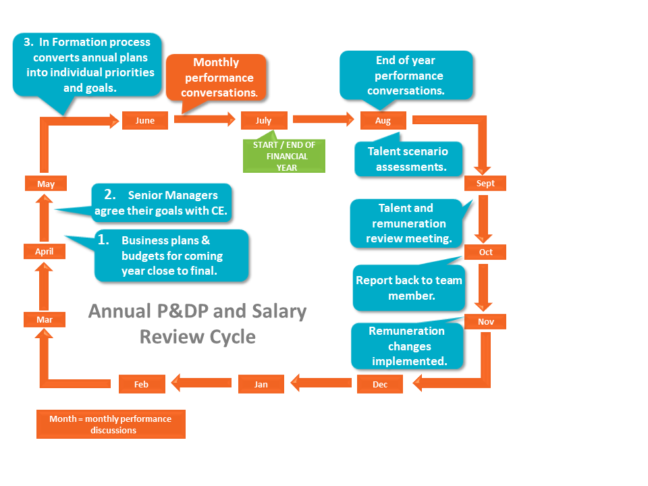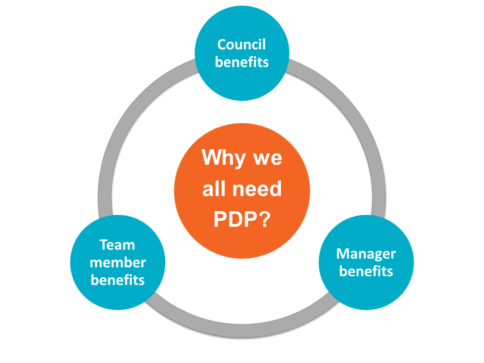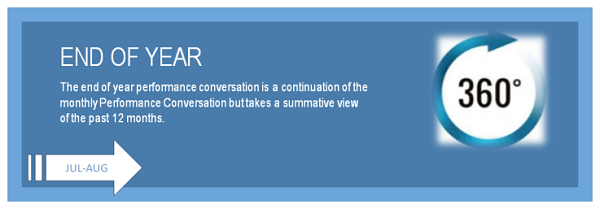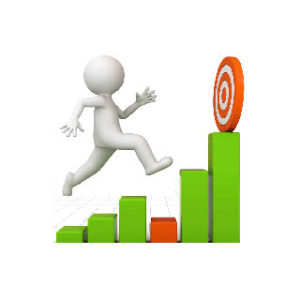What is P&DP?
Our Performance and Development Programme (P&DP) is a core business process that works to align the efforts of teams and individuals with our purpose, vision and goals. P&DP guides and supports each team member’s contribution to achieving breakthrough performance. P&DP is a year round process involving three key elements: In Formation (setting mission, responsibilities, goals and priorities), Performance Conversations (discussing expectations, progress and development) and End of year (reviewing and planning). Our guidelines help you lead PDP with your team.
Why do we all benefit from P&DP?
Our annual P&DP cycle and key activities
The three key elements of P&DP are explained below, followed by a cycle chart that shows how P&DP links with both our annual planning process, and our remuneration review process. Because P&DP is a year round series of conversations, we have the agility to change priorities and objectives as circumstances dictate. Note the strong link to our annual business planning and budget cycle. P&DP is a prime tool for helping us achieve our business goals and budgets in each year. It allows us to translate high-level group and team objectives for the year into individual objectives so that individual effort aligns strongly with our goals.
Your responsibility
- Fully understand the PD&P
- Ensure your team fully understand the P&DP
- Encourage their full and enthusiastic participation
- Involve your team in developing its purpose, mission and priorities
- Hold effective monthly performance conversations with each team member
- Set SMART goals with your team and monitoring progress monthly
- Regularly give informal feedback to your team
- Effectively lead the end of year process including 360° feedback, performance conversation identifying talent scenarios
Three key elements of the PDP process
Hover over each image for an explanation and links to resources you may need.
The Annual P&DP Cycle
P&DP is a year round process making our setting of objectives and priorities more agile and responsive to changes around us. The diagram below explains the key elements of the process as they happen through the year. It also explains the link between P&DP and our remuneration review process, which is driven by the talent scenario assessments produced by P&DP around August each year.

1. While PDP is a year round process it is vital we use it to align team and individual effort behind the business plans and budgets set for each financial year and which are derived directly from our LTP. By April each year, these plans and budgets are close to final.
2. Within council’s overall annual plan and budget, group managers and their teams have priorities, plans, budgets and KPIs for each area of our business. As these are confirmed with the executive team and CE they flow, through our In Formation process into the priorities, plans, budgets and KPIs of each team within the Group.
3. While our In Formation process operates throughout the year it’s particularly important as we prepare for the start of a new financial year that we engage with our teams to ensure team and individual effort is aligned with and will deliver on the organisations annual plan. This allows managers to involve their teams in modifying existing mission, priorities, KPIs, objectives, plans to align with our annual plan. In Formation activities include discussing and agreeing what the team priorities will be and how they will be achieved. Use our alignment workshops to facilitate the sessions.
End of Year Performance Conversations are a continuation of monthly performance conversations with two differences. First, prior to the end of year performance conversation, you have an opportunity to undertake, collate and interpret a structured online 360 degree feedback process on each of your team members. Second, during the end of year conversation this feedback is used to help you reach a summative (overall) view of the past year.
Talent and Remuneration Review Meeting. The individual talent scenario you assigned to each employee, is then reviewed and moderated at a Talent Review Meeting, convened by the Group Manager and facilitated by a member of the Organisational Development & Capability. The outputs from this meeting are a group-moderated Talent Scenario Assessment for each employee. These assessments are then used to create succession plans for key roles, to inform individual development plans and as the basis for remuneration review recommendations.
Report back to the employee. Following this meeting, the Organisational Development & Capability Team will provide a report to managers, which includes finalised individual talent scenario assessments and remuneration guidelines. Managers will use these to finalise the level of remuneration increase assigned to each employee within budget allocations, with these being signed off by their Group Manager. The Organisational Development & Capability Team will then generate individual letters for each employee, with the letters provided to the managers for distribution to their employees in one-on-one meetings. On receipt of these letters, you hold a one-on-one meeting with each team member to discuss their talent assessment and any remuneration changes and talk about their individual development plan.
Remuneration changes implemented. Remuneration changes resulting from this process take effect from October but are typically backdated to 1 July.
Waged team members – annual performance review process.
Waged team members annual performance review process is based on their Individual or Collective Employment Agreement.





